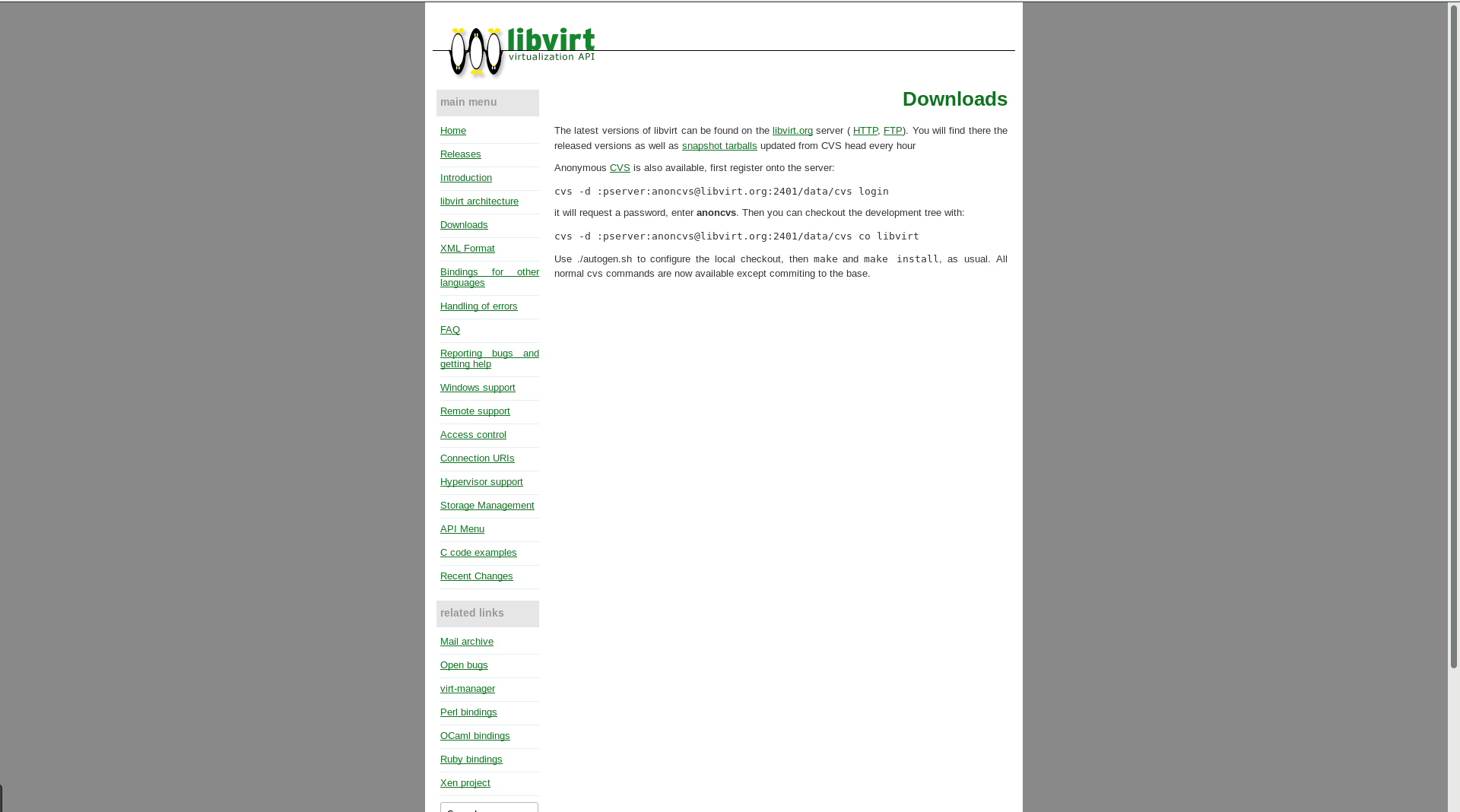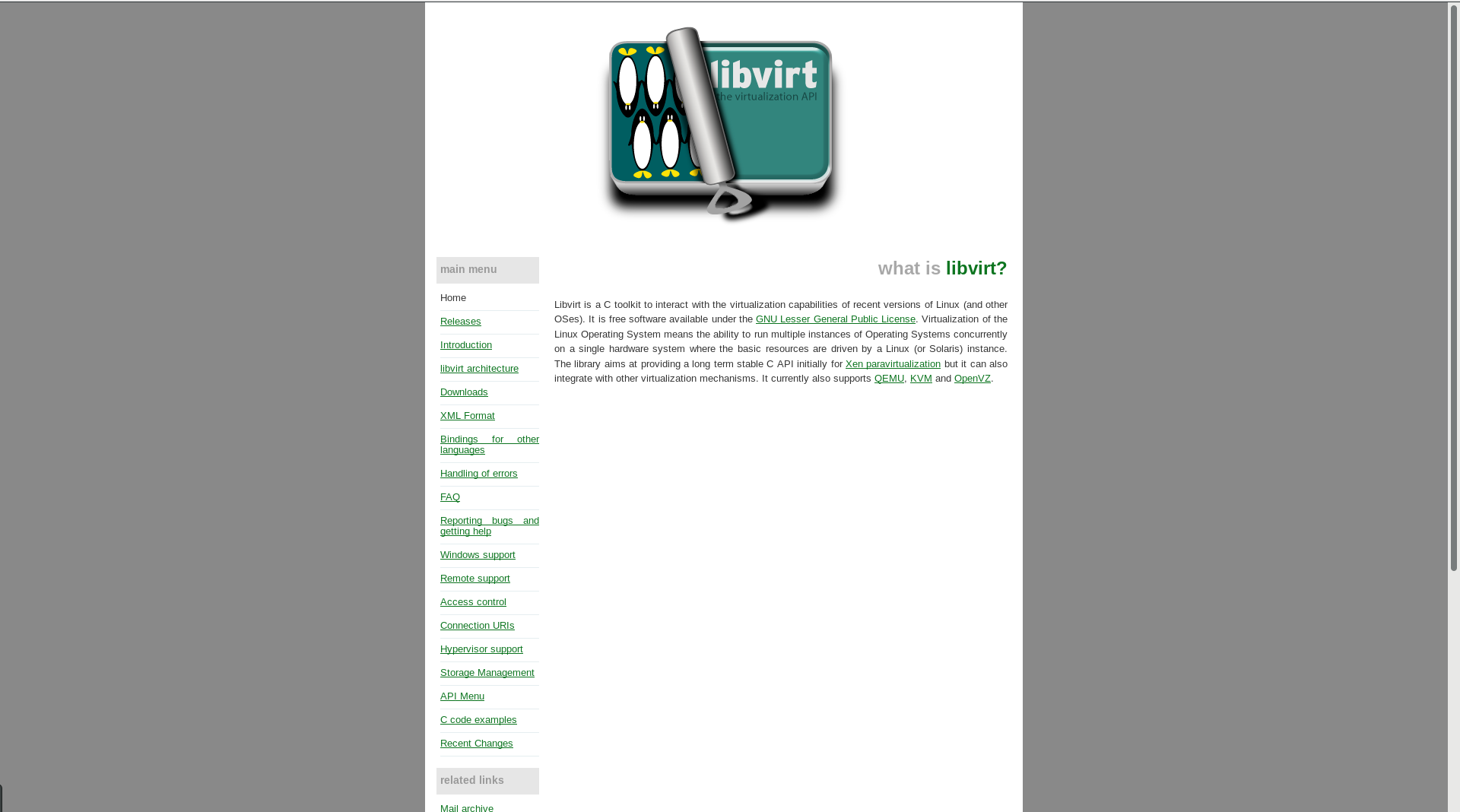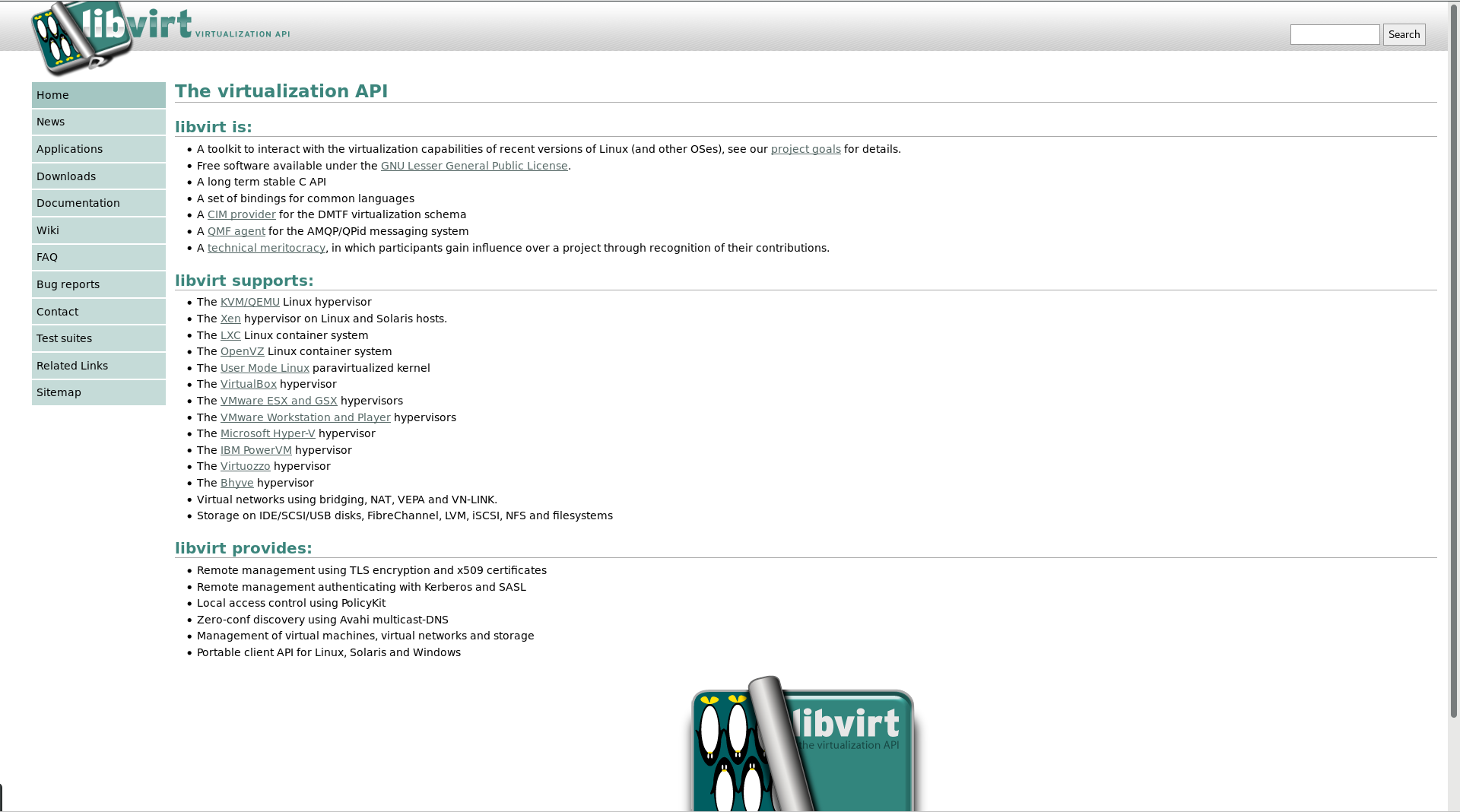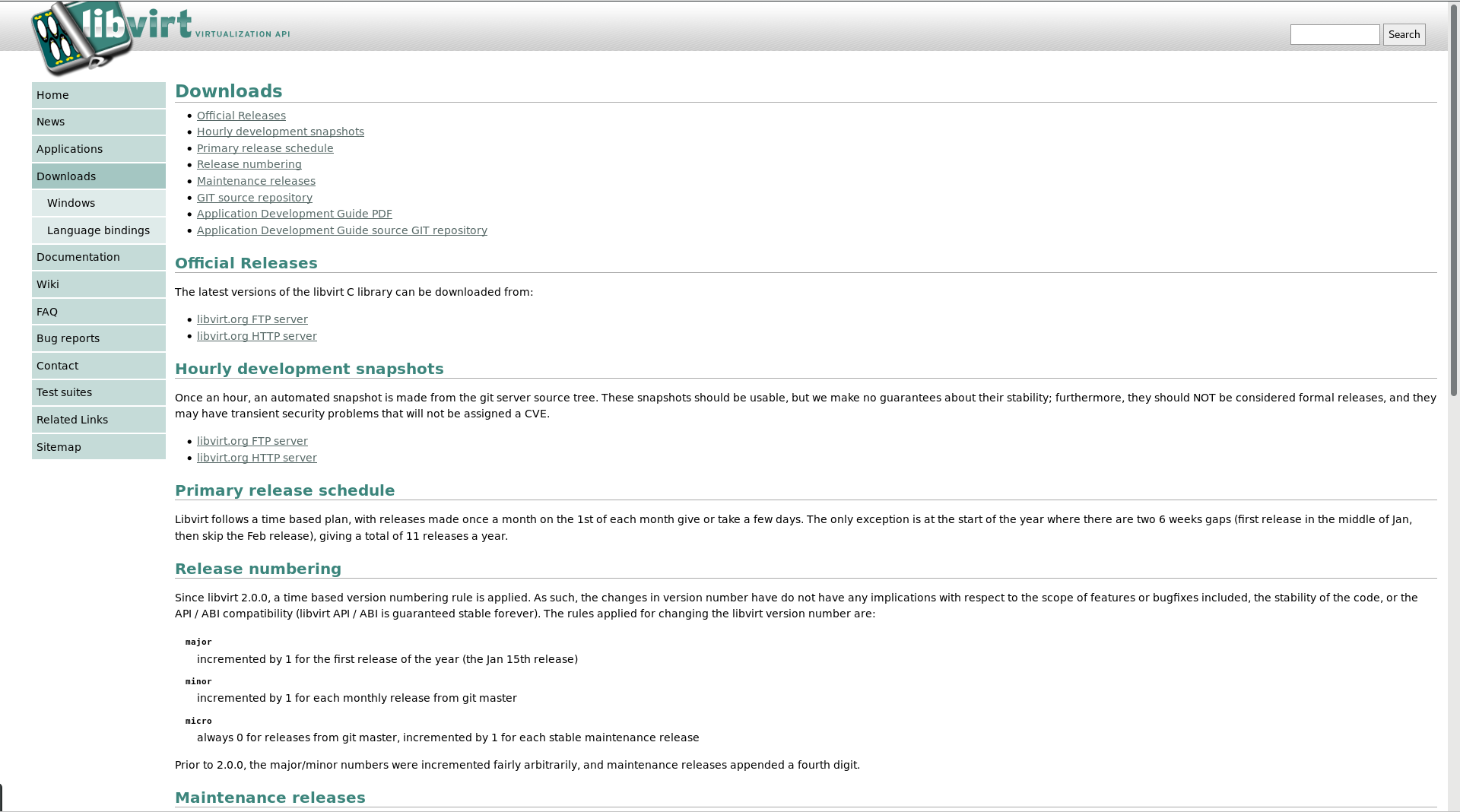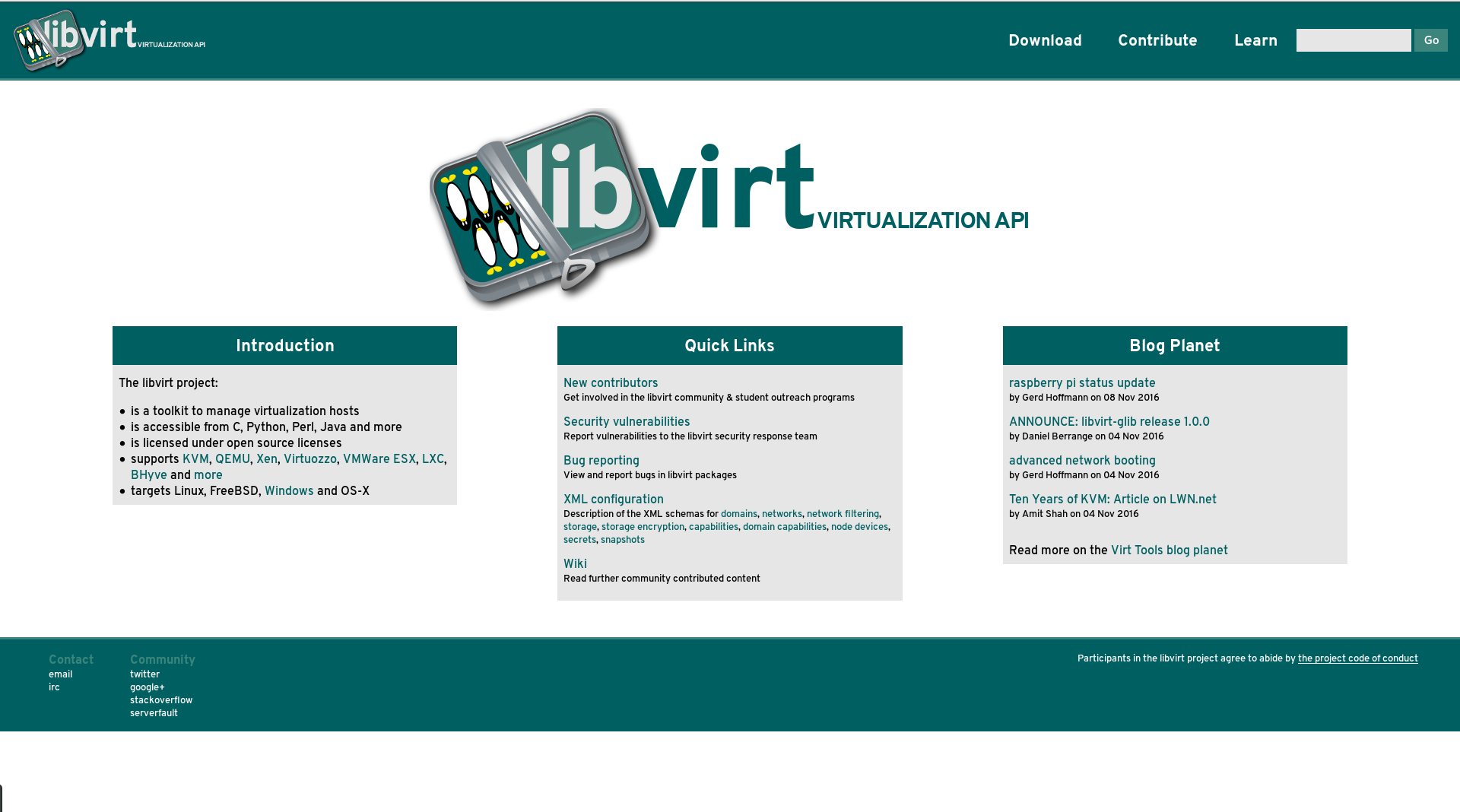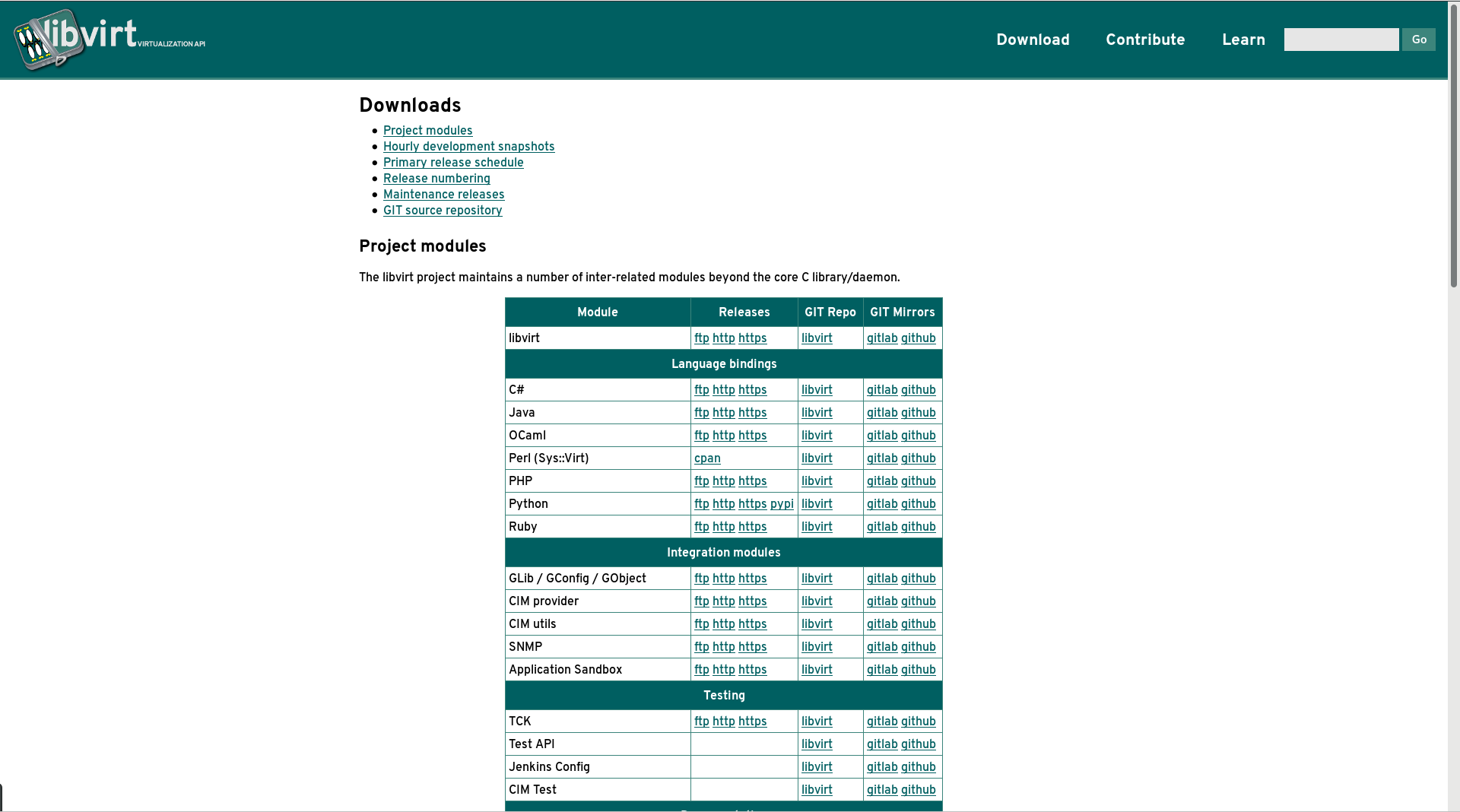Shortly before christmas, I announced the availability of new Go bindings for the libvirt API. This post announces a companion package for dealing with XML parsing/formatting in Go. The master repository is available on the libvirt GIT server, but it is expected that Go projects will consume it via an import of the github mirror, since the Go ecosystem is heavilty github focused (e.g. godoc.org can’t produce docs for stuff hosted on libvirt.org git)
import (
libvirtxml "github.com/libvirt/libvirt-go-xml"
"encoding/xml"
)
domcfg := &libvirtxml.Domain{Type: "kvm", Name: "demo",
UUID: "8f99e332-06c4-463a-9099-330fb244e1b3",
....}
xmldoc, err := xml.Marshal(domcfg)
API documentation is available on the godoc website.
When dealing with the libvirt API, most applications will find themselves needing to either parse or format XML documents describing configuration of various libvirt objects. Traditionally this task has been left upto the application to deal with and as a result most applications end up creating some kind of structure / object model to represent the XML document in a more easily accessible manner. To try to reduce this duplicate effort, libvirt has already created the libvirt-glib package, which contains a libvirt-gconfig library mapping libvirt XML documents into the GObject world. This library is accessible to many programming languages via the magic of GObject Introspection, and while there is some work to support this in Go, it is not particularly mature at this time.
In the Go world, there is a package “encoding/xml” which is able to transform between XML documents and Go structs, given suitable annotations on the struct fields. It is very easy to deal with, simply requiring someone to define a bit set of structs with annotated fields to map to the XML document. There’s no real “code” to write as it is really a data definition task. Looking at applications using libvirt in Go, we see quite a few have already go down this route for dealing with libvirt XML. It should be readily apparent that every application using libvirt in Go is essentially going to end up writing an identical set of structs to deal with the XML handling. This duplication of effort makes no sense at all, and as such, we have started this new libvirt-go-xml package to provide a standard set of Go structs to deal with libvirt XML. The current level of schema support is pretty minimal supporting the capabilities XML, secrets XML and a small amount of the domain XML, so we’d encourage anyone interested in this to contribute patches to expand the XML schema coverage.
The following illustrates a further example of its usage in combination with the libvirt-go library (with error checking omitted for brevity):
import (
libvirt "github.com/libvirt/libvirt-go"
libvirtxml "github.com/libvirt/libvirt-go-xml"
"encoding/xml"
"fmt"
)
conn, err := libvirt.NewConnect("qemu:///system")
dom := conn.LookupDomainByName("demo")
xmldoc, err := dom.GetXMLDesc(0)
domcfg := &libvirtxml.Domain{}
err := xml.Unmarshal([]byte(xmldocC), domcfg)
fmt.Printf("Virt type %s", domcfg.Type)
I’m happy to announce that the libvirt project is now supporting Go language bindings as a primary deliverable, joining Python and Perl, as language bindings with 100% API coverage of libvirt C library. The master repository is available on the libvirt GIT server, but it is expected that Go projects will consume it via an import of the github mirror, since the Go ecosystem is heavilty github focused (e.g. godoc.org can’t produce docs for stuff hosted on libvirt.org git)
import (
libvirt "github.com/libvirt/libvirt-go"
)
conn, err := libvirt.NewConnect("qemu:///system")
...
API documentation is available on the godoc website.
For a while now libvirt has relied on 3rd parties to provide Go language bindings. The one most people use was first created by Alex Zorin and then taken over by Kyle Kelly. There’s been a lot of excellent work put into these bindings, however, the API coverage largely stops at what was available in libvirt 1.2.2, with the exception of a few APIs from libvirt 1.2.14 which have to be enabled via Go build tags. Libvirt is now working on version 3.0.0 and there have been many APIs added in that time, not to mention enums and other constants. Comparing the current libvirt-go API coverage against what the libvirt C library exposes reveals 163 missing functions (out of 476 total), 367 missing enum constants (out of 847 total) and 165 missing macro constants (out of 200 total). IOW while there is alot already implemented, there was still a very long way to go.
Initially I intended to contribute patches to address the missing API coverage to the existing libvirt-go bindings. In looking at the code though I had some concerns about the way some of the APIs had been exposed to Go. In the libvirt C library there are a set of APIs which accept or return a “virTypedParameterPtr” array, for cases where we need APIs to be easily extensible to handle additions of an arbitrary extra data fields in the future. The way these APIs work is one of the most ugly and unpleasant parts of the C API and thus in language bindings we never expose the virTypedParameter concept directly, but instead map it into a more suitable language specific data structure. In Perl and Python this meant mapping them to hash tables, which gives application developers a language friendly way to interact with the APIs. Unfortunately the current Go API bindings have exposed the virTypedParameter concept directly to Go and since Go does not support unions, the result is arguably even more unpleasant in Go than it already is in C. The second concern is with the way events are exposed to Go – in the C layer we have different callbacks that are needed for each event type, but have one method for registering callbacks, requiring an ugly type cast. This was again exposed directly in Go, meaning that the Go compiler can’t do strong type checking on the callback registration, instead only doing a runtime check at time of event dispatch. There were some other minor concerns about the Go API mapping, such as fact that it needlessly exposed the “vir” prefix on all methods & constants despite already being in a “libvirt” package namespace, returning of a struct instead of pointer to a struct for objects. Understandably the current maintainer had a desire to keep API compatibility going forward, so the decision was made to fork the existing libvirt-go codebase. This allowed us to take advantage of all the work put in so far, while fixing the design problems, and also extending them to have 100% API coverage. The idea is that applications can then decide to opt-in to the new Go binding at a point in time where they’re ready to adapt their code to the API changes.
For users of the existing libvirt Go binding, converting to the new official libvirt Go binding requires a little bit of work, but nothing too serious and will simplify the code if using any of the typed parameter methods. The changes are roughly as follows:
- The “VIR_” prefix is dropped from all constants. eg libvirt.VIR_DOMAIN_METADATA_DESCRIPTION because libvirt.DOMAIN_METADATA_DESCRIPTION
- The “vir” prefix is dropped from all types. eg libvirt.virDomain becomes libvirt.Domain
- Methods returning objects now return a pointer eg “* Domain” instead of “Domain”, allowing us to return the usual “nil” constant on error, instead of a struct with no underlying libvirt connection
- The domain events DomainEventRegister method has been replaced by a separate method for each event type. eg DomainEventLifecycleRegister, DomainEventRebootRegister, etc giving compile time type checking of callbacks
- The domain events API now accepts a single callback, instead of taking a pair of callbacks – the caller can create an anonymous function to invoke multiple things if required.
- Methods accepting or returning typed parameters now have a formal struct defined to expose all the parameters in a manner that allows direct access without type casts and enables normal Go compile time type checking. eg the Domain.GetBlockIOTune method returns a DomainBlockIoTuneParameters struct
- It is no longer necessary to use Go compiler build tags to access functionality in different libvirt versions. Through the magic of conditional compilation, the binding will transparently build against every libvirt version from 1.2.0 through 3.0.0
- The binding can find libvirt via pkg-config making it easy to compile against a libvirt installed to a non-standard location by simply setting “PKG_CONFIG_PATH”
- There is 100% coverage of all APIs [1], constants and macros, verified by the libvirt CI system, so that it always keeps up with GIT master of the Libvirt C library.
- The error callback concept is removed from the binding as this is deprecated by libvirt due to not being thread safe. It was also redundant since every method already directly returns an error object.
- There are now explicit types defined for all enums and methods which take flags or enums now use these types instead of “uint32”, again allowing stronger compiler type checking
With the exception of the typed parameter changes adapting existing apps should be a largely boring mechanical conversion to just adapt to the renames.
Again, without the effort put in by Alex Zorin and Kyle Kelly & other community contributors, creation of these new libvirt-go bindings would have taken at least 4-5 weeks instead of the 2 weeks effort put into this. So there’s a huge debt owed to all the people who previously contributed to libvirt Go bindings. I hope that having these new bindings with guaranteed 100% API coverage will be of benefit to the Go community going forward.
[1] At time of writing this is a slight lie, as i’ve not quite finished the virStream and virEvent callback method bindings, but this will be done shortly.
Libvirt has long supported use of TLS for its remote API service, using the gnutls library as its backend. When negotiating a TLS session, there are a huge number of possible algorithms that could be used and the client & server need to decide on the best one, where “best” is commonly some notion of “most secure”. The preference for negotiation is expressed by simply having an list of possible algorithms, sorted best to worst, and the client & server choose the first matching entry in their respective lists. Historically libvirt has not expressed any interest in the handshake priority configuration, simply delegating the decision to the gnutls library on that basis that its developers knew better than libvirt developers which are best. In gnutls terminology, this means that libvirt has historically used the “DEFAULT” priority string.
The past year or two has seen a seemingly never ending stream of CVEs related to TLS, some of them particular to specific algorithms. The only way some of these flaws can be addressed is by discontinuing use of the affected algorithm. The TLS library implementations have to be fairly conservative in dropping algorithms, because this has an effect on consumers of the library in question. There is also potentially a significant delay between a decision to discontinue support for an algorithm, and updated libraries being deployed to hosts. To address this Fedora 21 introduced the ability to define the algorithm priority strings in host configuration files, outside of the library code. This system administrators can edit a file /etc/crypto-policies/config to change the algorithm priority for all apps using TLS on the host. After editting this file, the update-crypto-policies command is run to generate the library specific configuration files. For example, it populates /etc/crypto-policies/back-ends/gnutls.config In gnutls use of this file is enabled by specifying that an application wants to use the “@SYSTEM” priority string.
This is a good step forward, as it takes the configuration out of source code and into data files, but it has limited flexibility because it applies to all apps on the host. There can be two apps on a host which have mutually incompatible views about what the best algorithm priority is. For example, a web browser will want to be fairly conservative in dropping algorithms to avoid breaking access to countless websites. An application like libvirtd though, where there is a well known set of servers and clients to connect in any site, can be fairly aggressive in only supporting the very best algorithms. What is desired is a way to override the algorithm priorty per application. Now of course this can easily be done via the application’s own configuration file, and so libvirt has added a new parameter “tls_priority” to /etc/libvirt/libvirtd.conf
The downside of using the application’s own configuration, is that the system administrator has to go hunting through many different files to update each application. It is much nicer to have a central location where the TLS priority settings for all applications can be controlled. What is desired is a way for libvirt to be built such that it can tell gnutls to first look for a libvirt specific priority string, and then fallback to the global priority string. To address this patches were written for GNUTLS to extend its priority string syntax. It is now possible to for libvirt to pass “@LIBVIRT,SYSTEM” to gnutls as the priority. It will thus read /etc/crypto-policies/back-ends/gnutls.config first looking for an entry matching “LIBVIRT” and then looking for an entry matching “SYSTEM“. To go along with the gnutls change, there is also an enhancement to the update-crypto-policies tool to allow application specific entries to be included when generating the /etc/crypto-policies/back-ends/gnutls.config file. It is thus possible to configure the libvirt priority string by simply creating a file /etc/crypto-policies/local.d/gnutls-libvirt.config containing the desired string and re-running update-crypto-policies.
In summary, the libvirt default priority settings are now:
- RHEL-6/7 –
NORMAL – a string hard coded in gnutls at build time
- Fedora < 25 -
@SYSTEM – a priority level defined by sysadmin based on /etc/crypto-policies/config
- Fedora >= 25 –
@LIBVIRT,SYSTEM – a raw priority string defined in /etc/crypto-policies/local.d/gnutls-libvirt.config, falling back to /etc/crypto-policies/config if not present.
In all cases it is still possible to customize in /etc/libvirt/libvirtd.conf via the tls_priority setting, but it is is recommended to use the global system /etc/crypto-policies facility where possible.
The current previous libvirt website design dated from circa 2008 just a few years after the libvirt project started. We have grown alot of content since that time, but the overall styling and layout of the libvirt website has not substantially changed. Compared to websites for more recently launched projects, libvirt was starting to look rather outdated. So I spent a little time to come up with a new design for the libvirt website to bring it into the modern era. There were two core aspects to the new design, simplify the layout and navigation, and implement new branding.
From the layout / navigation POV we have killed the massive expanding menu that was on the left hand side of every page. It was not serving its purpose very effectively since it was requiring far too many clicks & page loads to access some of the most frequently needed content. The front page now has direct links to key pieces of content (as identified from our web access stats), while the rest of the pages are directly visible in a flat menu on the “docs” page. The download page has been overhauled to recognise the fact that libvirt is shipping more than just the core C library – we have language bindings, object model mappings, docs and test suites. Also new is a page directly targeting new contributors with information about how to get involved in the project and the kind of help we’re looking for. The final notable change is used of some jquery magic to pull in a feed of blog posts to the site front page.
From the branding POV, we have taken the opportunity to re-create the project logo. We sadly lost the original master vector artwork used to produce the libvirt logo eons ago, so only had a png file of it in certain resolutions. When creating docbook content, we did have a new SVG created that was intended to mirror the original logo, but it was quite crudely drawn. None the less it was a useful basis to start from to create new master logo graphics. As a result we now have an attractively rendered new logo for the project, available in two variants – a standard square(-ish) format
and in a horizontal banner format
With the new logo prepared, we took the colour palette and font used in the graphic and applied both to the main website content, bringing together a consistent style.
Libvirt website v1 (2006-2008)
Libvirt website v2 (2008-2016)
Libvirt website v3 (2016-)
This blog is part 7 of a series I am writing about work I’ve completed over the past few releases to improve QEMU security related features.
The live migration feature in QEMU allows a running VM to be moved from one host to another with no noticeable interruption in service and minimal performance impact. The live migration data stream will contain a serialized copy of state of all emulated devices, along with all the guest RAM. In some versions of QEMU it is also used to transfer disk image content, but in modern QEMU use of the NBD protocol is preferred for this purpose. The guest RAM in particular can contain sensitive data that needs to be protected against any would be attackers on the network between source and target hosts. There are a number of ways to provide such security using external tools/services including VPNs, IPsec, SSH/stunnel tunnelling. The libvirtd daemon often already has a secure connection between the source and destination hosts for its own purposes, so many years back support was added to libvirt to automatically tunnel the live migration data stream over libvirt’s own secure connection. This solved both the encryption and authentication problems at once, but there are some downsides to this approach. Tunnelling the connection means extra data copies for the live migration traffic and when we look at guests with RAM many GB in size, the number of data copies will start to matter. The libvirt tunnel only supports a tunnelling of a single data connection and in future QEMU may well wish to use multiple TCP connections for the migration data stream to improve performance of post-copy. The use of NBD for storage migration is not supported with tunnelling via libvirt, since it would require extra connections too. IOW while tunnelling over libvirt was a useful short term hack to provide security, it has outlived its practicality.
It is clear that QEMU needs to support TLS encryption natively on its live migration connections. The QEMU migration code has historically had its own distinct I/O layer called QEMUFile which mixes up tracking of migration state with the connection establishment and I/O transfer support. As mentioned in previous blog post, QEMU now has a general purpose I/O channel framework, so the bulk of the work involved converting the migration code over to use the QIOChannel classes and APIs, which greatly reduced the amount of code in the QEMU migration/ sub-folder as well as simplifying it somewhat. The TLS support involves the addition of two new parameters to the migration code. First the “tls-creds” parameter provides the ID of a previously created TLS credential object, thus enabling use of TLS on the migration channel. This must be set on both the source and target QEMU’s involved in the migration.
On the target host, QEMU would be launched with a set of TLS credentials for a server endpoint:
$ qemu-system-x86_64 -monitor stdio -incoming defer \
-object tls-creds-x509,dir=/home/berrange/security/qemutls,endpoint=server,id=tls0 \
...other args...
To enable incoming TLS migration 2 monitor commands are then used
(qemu) migrate_set_str_parameter tls-creds tls0
(qemu) migrate_incoming tcp:myhostname:9000
On the source host, QEMU is launched in a similar manner but using client endpoint credentials
$ qemu-system-x86_64 -monitor stdio \
-object tls-creds-x509,dir=/home/berrange/security/qemutls,endpoint=client,id=tls0 \
...other args...
To enable outgoing TLS migration 2 monitor commands are then used
(qemu) migrate_set_str_parameter tls-creds tls0
(qemu) migrate tcp:otherhostname:9000
The migration code supports a number of different protocols besides just “tcp:“. In particular it allows an “fd:” protocol to tell QEMU to use a passed-in file descriptor, and an “exec:” protocol to tell QEMU to launch an external command to tunnel the connection. It is desirable to be able to use TLS with these protocols too, but when using TLS the client QEMU needs to know the hostname of the target QEMU in order to correctly validate the x509 certificate it receives. Thus, a second “tls-hostname” parameter was added to allow QEMU to be informed of the hostname to use for x509 certificate validation when using a non-tcp migration protocol. This can be set on the source QEMU prior to starting the migration using the “migrate_set_str_parameter” monitor command
(qemu) migrate_set_str_parameter tls-hostname myhost.mydomain
This feature has been under development for a while and finally merged into QEMU GIT early in the 2.7.0 development cycle, so will be available for use when 2.7.0 is released in a few weeks. With the arrival of the 2.7.0 release there will finally be TLS support across all QEMU host services where TCP connections are commonly used, namely VNC, SPICE, NBD, migration and character devices.
In this blog series:


